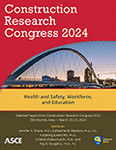Factors Preventing Construction Management from Adopting Wearable Sensing Devices in Construction Safety
Publication: Construction Research Congress 2024
ABSTRACT
Sensing technologies demonstrate promising potential in improving construction safety. The current research efforts focus on the sensing technologies development, yet these technologies are not implemented or are in the initial stages of adoption in the construction sector. This paper aims to understand the constructs that prevent decision-makers from adopting these technologies to enhance the safety of field labor. A modified unified theory of acceptance and use of technology (UTAUT) was developed to study the barriers commonly found within technology adoption in the construction industry. The model addressed the perceived performance expectancy, perceived effort expectancy, openness to data utilization, social influence, data security, and facilitating conditions. A closed-ended questionnaire was used to collect the study data. The study found that an association was found between behavioral intent to implement a biometric wearable sensing device and perceived performance expectancy, openness to data utilization, and the social influence of the client.
Get full access to this article
View all available purchase options and get full access to this chapter.
REFERENCES
Anliker, U., et al. 2004. “AMON: a wearable multiparameter medical monitoring and alert system.” IEEE Transactions on Information Technology in Biomedicine, 8 (4): 415–427. https://doi.org/10.1109/TITB.2004.837888.
Awolusi, I., E. Marks, and M. Hallowell. 2018. “Wearable technology for personalized construction safety monitoring and trending: Review of applicable devices.” Autom Constr, 85: 96–106. https://doi.org/https://doi.org/10.1016/j.autcon.2017.10.010.
Choi, B., S. Hwang, and S. Lee. 2017. “What drives construction workers’ acceptance of wearable technologies in the workplace?: Indoor localization and wearable health devices for occupational safety and health.” Autom Constr, 84: 31–41. https://doi.org/https://doi.org/10.1016/j.autcon.2017.08.005.
Construction, M. H. 2013. Safety management in the construction industry: Identifying risks and reducing accidents to improve site productivity and project ROI. Bedford, MA: Author.
Davis, F., R. Bagozzi, and P. Warshaw. 2006. “Extrinsic and Intrinsic Motivation to Use Computers in the Workplace1.” J Appl Soc Psychol, 22: 1111–1132. https://doi.org/10.1111/j.1559-1816.1992.tb00945.x.
Dzeng, R.-J., Y.-C. Fang, and I.-C. Chen. 2014. “A feasibility study of using smartphone built-in accelerometers to detect fall portents.” Autom Constr, 38: 74–86. https://doi.org/https://doi.org/10.1016/j.autcon.2013.11.004.
Gupta, B., A. Chaudhary, N. Sindhwani, and A. Rana. 2021. “Smart Shoe for Detection of Electrocution Using Internet of Things (IoT).” 2021 9th International Conference on Reliability, Infocom Technologies and Optimization (Trends and Future Directions) (ICRITO), 1–3.
JeeWoong, P., M. Eric, Y. K. Cho, and S. Willy. 2016. “Performance Test of Wireless Technologies for Personnel and Equipment Proximity Sensing in Work Zones.” J Constr Eng Manag, 142 (1): 4015049. American Society of Civil Engineers. https://doi.org/10.1061/(ASCE)CO.1943-7862.0001031.
Jin, R., P. X. W. Zou, P. Piroozfar, H. Wood, Y. Yang, L. Yan, and Y. Han. 2019. “A science mapping approach based review of construction safety research.” Saf Sci, 113: 285–297. Elsevier.
Luczak, T., R. Burch, E. Lewis, H. Chander, and J. Ball. 2019. “State-of-the-art review of athletic wearable technology: What 113 strength and conditioning coaches and athletic trainers from the USA said about technology in sports.” Int J Sports Sci Coach, 15 (1): 26–40. SAGE Publications. https://doi.org/10.1177/1747954119885244.
McNinch, M., D. Parks, R. Jacksha, and A. Miller. 2019. “Leveraging IIoT to Improve Machine Safety in the Mining Industry.” Min Metall Explor, 36 (4): 675–681. https://doi.org/10.1007/s42461-019-0067-5.
Michaels, D. 2016. “Year one of OSHA’s severe injury reporting program: An impact evaluation.” https://www. osha. gov/injuryreport/2015.pdf. Accessed October, 23: 2017.
Nnaji, C., I. Awolusi, J. Park, and A. Albert. 2021. “Wearable Sensing Devices: Towards the Development of a Personalized System for Construction Safety and Health Risk Mitigation.” Sensors.
Okpala, I., C. Nnaji, I. Awolusi, and A. Akanmu. 2021. “Developing a Success Model for Assessing the Impact of Wearable Sensing Devices in the Construction Industry.” J Constr Eng Manag, 147 (7): 4021060. American Society of Civil Engineers.
OSHA. 2020. Commonly Used Statistics. United States Department of Labor.
Schall, M. C. J., R. F. Sesek, and L. A. Cavuoto. 2018. “Barriers to the Adoption of Wearable Sensors in the Workplace: A Survey of Occupational Safety and Health Professionals.” Hum Factors, 60 (3): 351–362. United States. https://doi.org/10.1177/0018720817753907.
Shin, D. H. 2009. “Towards an understanding of the consumer acceptance of mobile wallet.” Comput Human Behav, 25 (6): 1343–1354. Pergamon. https://doi.org/10.1016/J.CHB.2009.06.001.
Venkatesh, V., M. G. Morris, G. B. Davis, and F. D. Davis. 2003. “User Acceptance of Information Technology: Toward a Unified View.” MIS Quarterly, 27 (3): 425–478. Management Information Systems Research Center, University of Minnesota. https://doi.org/10.2307/30036540.
Zhang, J., P. Xiang, R. Zhang, D. Chen, and Y. Ren. 2020. “Mediating Effect of Risk Propensity between Personality Traits and Unsafe Behavioral Intention of Construction Workers.” J Constr Eng Manag, 146 (4): 04020023. American Society of Civil Engineers. https://doi.org/10.1061/(ASCE)CO.1943-7862.0001792.
Information & Authors
Information
Published In
History
Published online: Mar 18, 2024
ASCE Technical Topics:
Authors
Metrics & Citations
Metrics
Citations
Download citation
If you have the appropriate software installed, you can download article citation data to the citation manager of your choice. Simply select your manager software from the list below and click Download.
